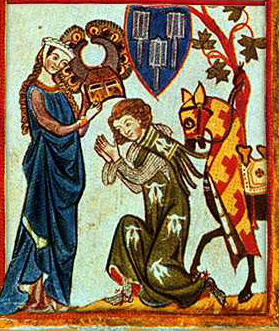THE MIRACLE OF LOVE, the answer of the real
Sun. September 26, 2004Categories: Abstract Dynamics

In answer to those who think that Glamasochism makes impossible demands of women, I would recommend Zizek’s wonderful ‘Courtly Love, or Woman as Thing’ from Metastases of Enjoyment. (Acquired for TWO QUID while out with Infinite Thought and Alberto yesterday — only in Stoke Newington could you find Slavoj in a charity shop for £2!)
It is not that I or other advocates of Glamasochists have ‘made up’ the Idealization of Woman. Such Idealization is presupposed in any erotic love relation – which, as Lacan insists, can never be a relationship between persons, in part because only in the minds of Teenage Ontologists and Guardian Women’s Page readers are there ‘real persons’. What erotic love entails is the two roles of the capricious and cold Ladytron (‘a machine which utters meaningless desires as random’) and the servant-bondsman-Knight. These are roles, or rather, machinic functions, and as Zizek’s example of The Crying Game, or my examples of Amanda Lear on the cover of Roxy’s For Your Pleasure and Balzac’s Sarrazine make clear, there is no question of biological essentialism here: men, women, heterosexual or homosexual, can play the function of either Lady or Knight. And play them they must if the game of love is to begin.
(A brief note here: yes, masochism is a perversion — but, as Zizek rightly observes, it is the retrospectively understood truth of Middle Ages Courtly Love, from which all our notions of erotic – sometimes misleadingly called ‘romantic’ – love derive).
Paradoxically, in any case, the Ideal is the Real – the unattainable limit, the Deleuze-Guattari Body without Organs (and as Irigaray says in This Sex Which is Not One, women have always been Bodeis withour Organs). It is this Real which Lacan, following Freud, calls Das Ding, or the Thing. I love you for what is in you more than yourself. Again paradoxically, it is precisely when the Object attains subjectivity that when the game moves over a threshold into a desubjecifying machinic encounter and the “miracle of love” occurs.
‘From a capricious and ironic sovereign Lady, she changes into the pathetic figure of a delicate, sensitive boy who is desperately in love. It is at this point that true love emerges, love as a metaphor in the Lacanian sense: we witness the sublime moment when eromenos (the loved one) changes into erastes (the loving one) by stretching out her hand and “returning love”. This moment designates the “miracle” of love, the moment of the “answer of the Real”; as such, it perhaps enables us to grasp what Lacan has in mind when he insists that the subject itself has the status of an “answer of the Real”. That is to say, up to this reverse, the loved one has the status of the object: he is loved on account of something that is “in him more than himself” and that he is unaware of – I can never answer the question ‘what am I as an object for the other? What does the other see in me that causes his love?’ We thus confront an assymetry, not only the assymetry between subject and object, but in a far more radical sense of a dischord between what the lover sees in the loved one and what the loved one knows himself to be.
Here we find the inescapable deadlock that defines the position of the loved one: the other sees something in and me and wants something from me, but I cannot give him what I do not possess – or, as Lacan puts it, there is no relationship between what the loved one possesses and what the loving one lacks. The only way for the loved one to escape this deadlock is to reach out his hand towards the loving one and “return the love” – that is, to exchange in a metaphorical gesture, his status as the loved one for the status of the loving one. This reversal designates the point of subjectivization: the object of love changes into a subject the moment it answers the call of love. And it is only by way of this reversal that a genuine love emerges: I am truly in love not when I as simply fascinated by the agalma in the other, but when I experience the other, the object of love, as frail and lost, as lacking “it”, and my love none the less survives the loss.
We must be especially attentive here so that we do not miss the point of this reversal: although we now have two loving subjects instead of the initial duality of the loving one and the loved one, the asymmetry persists, since it was the object itself that, as it were, confessed to its lack by means of its subjectivization. Something deeply embarrassing and truly scandalous abides in the reversal by means of which the mysterious, fascinating, elusive object of love discloses its deadlock, and thus acquires the status of another subject.’ (103-104)

The contemporary degraded and coarsely sexualized version of erotic love has renaturalized and biologized this miraculous moment as the time in which copulation happens. But in Courly Love proper, sex can be part of the initial phase of femachinic Master and attentive Servant. It need not be the semiotic trigger for the threshold shift into the miraculous encounter. No – the trigger is the moment when the Master shows the Servant ‘mercy’. Let’s be clear that this is not the end of the game, the shedding of masks and appearances to uncover the empirical subject beneath them, or worse, the prelude to reproducer-domesticated coupledom. Or at least it need not be. It can be the start of an even more challenging, even more complex and intense game, one that can last a lifetime at least.